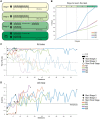A novel task to investigate vibrotactile detection in mice
- PMID: 37079581
- PMCID: PMC10118142
- DOI: 10.1371/journal.pone.0284735
A novel task to investigate vibrotactile detection in mice
Abstract
Throughout the last decades, understanding the neural mechanisms of sensory processing has been a key objective for neuroscientists. Many studies focused on uncovering the microcircuit-level architecture of somatosensation using the rodent whisker system as a model. Although these studies have significantly advanced our understanding of tactile processing, the question remains to what extent the whisker system can provide results translatable to the human somatosensory system. To address this, we developed a restrained vibrotactile detection task involving the limb system in mice. A vibrotactile stimulus was delivered to the hindlimb of head-fixed mice, who were trained to perform a Go/No-go detection task. Mice were able to learn this task with satisfactory performance and with reasonably short training times. In addition, the task we developed is versatile, as it can be combined with diverse neuroscience methods. Thus, this study introduces a novel task to study the neuron-level mechanisms of tactile processing in a system other than the more commonly studied whisker system.
Copyright: © 2023 Muller et al. This is an open access article distributed under the terms of the Creative Commons Attribution License, which permits unrestricted use, distribution, and reproduction in any medium, provided the original author and source are credited.
Conflict of interest statement
The authors have declared that no competing interests exist.
Figures





Similar articles
-
Involvement of human primary somatosensory cortex in vibrotactile detection depends on task demand.Neuroimage. 2016 Sep;138:184-196. doi: 10.1016/j.neuroimage.2016.05.056. Epub 2016 May 24. Neuroimage. 2016. PMID: 27233148
-
Novel two-alternative forced choice paradigm for bilateral vibrotactile whisker frequency discrimination in head-fixed mice and rats.J Neurophysiol. 2013 Jan;109(1):273-84. doi: 10.1152/jn.00488.2012. Epub 2012 Oct 10. J Neurophysiol. 2013. PMID: 23054598
-
Functional Localization of an Attenuating Filter within Cortex for a Selective Detection Task in Mice.J Neurosci. 2020 Jul 8;40(28):5443-5454. doi: 10.1523/JNEUROSCI.2993-19.2020. Epub 2020 Jun 2. J Neurosci. 2020. PMID: 32487695 Free PMC article.
-
Representation of tactile scenes in the rodent barrel cortex.Neuroscience. 2018 Jan 1;368:81-94. doi: 10.1016/j.neuroscience.2017.08.039. Epub 2017 Aug 23. Neuroscience. 2018. PMID: 28843997 Review.
-
Tactile cognition in rodents.Neurosci Biobehav Rev. 2023 Jun;149:105161. doi: 10.1016/j.neubiorev.2023.105161. Epub 2023 Apr 5. Neurosci Biobehav Rev. 2023. PMID: 37028580 Review.
References
Publication types
MeSH terms
LinkOut - more resources
Full Text Sources

